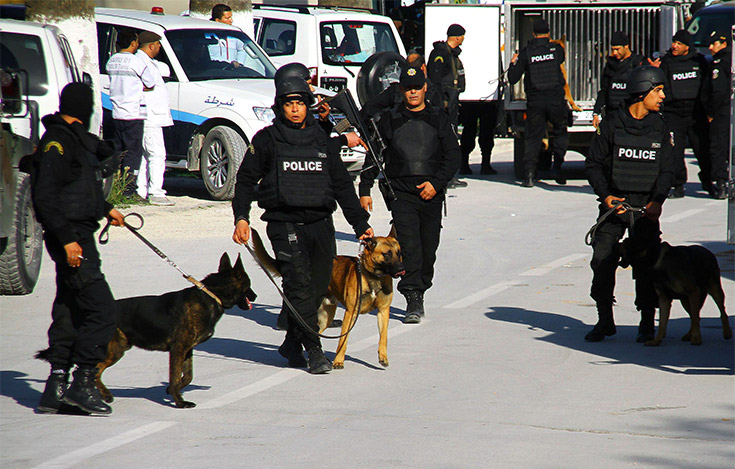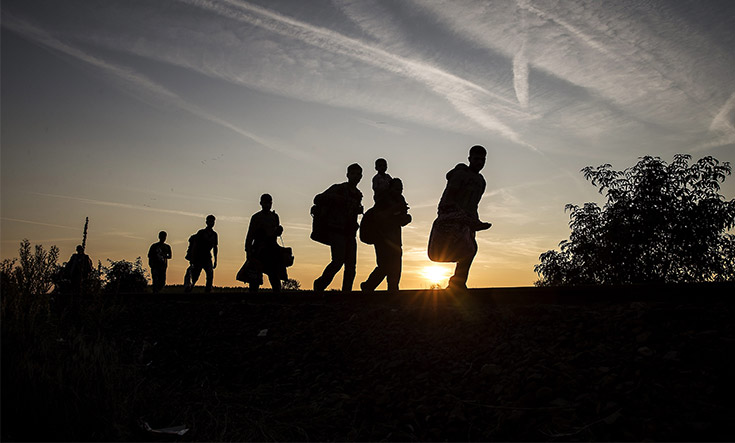Milipol Paris: update
Milipol Paris has issued a statement: "We are shocked and saddened by the terrorist attacks that happened last night in Paris. Our sympathy goes out to the families of the victims."
"Following the tragic events in Paris, MILIPOL and its organisers are putting in place increased security measures (bag checks, entry controls and security personnel) and are working with the law enforcement authorities to optimise security at the event.
"Obviously, the French Government might decide to introduce further measures in the next few days. International flights and trains into France continue to operate normally (although with a few delays). The exhibition will open as planned and the Comexposium teams are at the disposal of exhibitors and visitors to answer their questions and concerns. We shall, of course, keep you informed if the situation changes."
This is an update to a news entry already published (see below)
This November, Milipol Paris will feature CRJ keynotes and audience debate, with Editorial Panel Member Lina Kolesnikova, Specialist Editors Ian Portelli and Andy Marshall, and Editor in Chief Emily Hough.
The Milipol event is organised under the patronage of the French Ministry of Interior, carried out in partnership with the French National Police and Gendarmerie, Civil Defence, French Customs and Interpol.
The CRJ session will feature two keynote presentations, the first being from our Chief Scientific Editor, Dr Ian Portelli, who will be talking about innovation, research and development leading to future trends in disaster management, medicine and technology.

The pocket-size drone from Prox Dynamics
From pocket-size drones to protective suits for Ebola caregivers, remarkable innovations have been made across the science and technology fields. For example, responders who seek to collect information to co-ordinate their response can use one of the many robots or drones available; there are robots that mimic the movements of apes, snakes and scorpions, which can manoeuvre on all types of terrain; drones small enough to fit in a pocket; and camera balls that can be tossed into any area of interest.
There are other advances can help first responders who need to reach and treat victims of a disaster or emergency. Responders could use drones to deliver vital supplies, or medical advances like a haemostasis system that can seal gunshot wounds in seconds. At the Milipol Conference, Dr Portelli will discuss these innovations and how they may be adapted for use in disaster situations.
After this, CRJ Editorial Advisory Panel Member Lina Kolesnikova will present the second keynote, examining the challenges of responding to attacks on soft targets, drawing upon lessons from recent events.

Lina Kolesnikova will discuss the challenges of protecting against and response to soft target attacks, such as the attack on tourists at the Bardo National Museum in Tunisia, March 2015 (photo: ddp USA / Rex/ Shutterstock)
Protecting soft targets from potential terrorist attacks without compromising accessibility and/or efficiency is the critical challenge. Analysing some of the recent soft target attacks, we see that this phenomenon is becoming ever-more dangerous, as the barriers are being lowered for new terrorists to become more destructive.
This presentation will examine the twin challenges of protection and response to these evolving threats.
Following the keynote presentations, CRJ’s Urban Resilience Editor Andy Marshall will chair a panel discussion with Ian Portelli, Lina Kolesnikova, Crisis Response Journal’s Editor in Chief Emily Hough and a representative from the French Commissariat à l’énergie atomique et aux énergies alternatives (CEA).
The discussion, which will involve the audience, will examine the greatest challenges facing the field of crisis management in the next decade. We will focus on three main topics:
Climate
Geopolitics and economics
Technological Advances
All three areas have received extensive coverage in CRJ over the last few years so there is a direct correlation between our presentations at Milipol and the debates that we have promoted through our published material. Our two keynote addresses will re-visit these topics in more detail and begin to look at how they impact on crises and crisis management, raising questions that we will re-visit during the panel discussion.
The chaired panel discussion will seek to explore the three identified themes in more detail. The aim is not just to explore in more detail but to widen the discussion, promote debate and establish a platform for sharing relevant ideas, experience and good practice from a richly diverse international perspective. In so doing, we will recognise the focus on the Military and Police roles in a crisis, while embracing the wider strategic and multi-agency context of modern resilience.
Climate
Disruption caused by our changing climate is unpredictable, it pervades all aspects of our lives, manifesting as massive storms, flooding and sea level rises, drought, snowstorms, heat waves, power blackouts, and so on. Eleven years ago, when we launched Crisis Response Journal, we started to research emergency service and response perspectives on climate change. Almost unanimously, our respondents said that climate change did not – and would not – affect their roles. Experience shows that they were wrong.
Climate effects could render some cities uninhabitable – and make no mistake, climate change affects governments, health, local emergency services, business, the police, military and all other aspects of emergency response or security planning.
Aside from the immediate impacts of extreme climate events, their far ranging effects can be even more disruptive. Of course, some areas are more prone to natural disasters; we know about these and, to some extent, can prepare for and mitigate against their effects, although whether this is being done effectively in all nations – or regions – around the world is open to question.
The fact is that some natural hazards and disasters are not unusual and have occurred on a historically regular basis. Other areas we may explore include whether impacts on people are getting worse because of inappropriate human settlement, whether our approach to designing, managing and planning the built environment helps or hinders resilience and whether organisations and individuals are genuinely linking adaptation with safer, more secure societies.

The panel discussion will discuss current crises, such as that of migrants, displaced persons and refugees, within the wider multi-agency context of resilience, with reference to the roles of the Military and Police (IBL / Rex / Shutterstock)
Geopolitics & Economics
Wars, conflict, terrorism and security issues… Some of these events are caused by ideology, but others are precipitated or aggravated by our previous topic of discussion, namely natural resource pressures and climate-related incidents. If one area becomes uninhabitable, displacing residents and communities – whether through floods, famine, drought, etc – more pressure is placed on other areas and communities. All of this creates instability and can breed extreme ideologies, which may lead to resentment that fuels radicalisation and terrorism, etc.
Aside from the immediate threats, fallout includes displaced persons, migrants, refugees and wider humanitarian emergencies. The cascading effects of a smaller crisis can have immense ramifications that stretch far beyond one region’s – or even a nation’s – increasingly porous borders. Moreover, geopolitics and economics are natural bedfellows.
So what implications are there for crisis response from the global economic downturn and the so-called ‘age of austerity’? Is crisis response destined to lose out in the battle for scarce resources and long-term investment? Are we making an effective business case for resilience as a key component in the wider geopolitical and security challenge or are we looking to simply do ‘more with less’?
Technological Advances.
Could technology be the catalyst for exponential change in crisis management? Given the societal impact of technology, particularly through access to affordable platforms and solutions at the personal level, technology may provide unparalleled opportunities to enhance the speed and scope of crisis response, irrespective of the political and economic pressures we face. Consider for a moment how the ‘simple’ smartphone has revolutionised just about every aspect of emergency and security preparedness and response.
From providing greater communications (with invaluable video and picture facilities in the field), to allowing people in remote areas to call for help, along with a proliferation of apps for response, education and safer cities, the smartphone has also made an immense contribution in creating virtual communities, engaging with society and building a more resilient world.
The rise of digital humanitarianism is expected to continue: What are the implications for traditional emergency responders? (123RF)
However, while we are seeing an immense burgeoning of all types of technology, every development has immense potential for good or, in the wrong hands, for bad.
The trends that CRJ – and its Research and Development blog, as mentioned above – are seeing for the future with regard to technology in the security, safety and emergency response field include:
Drones and robotics: Drones are already being used in all manner of security, rescue and humanitarian applications, from command and control, surveillance, intelligence, reconnaissance, to deliveries of humanitarian or medical supplies in remote or cut off areas, and search and rescue. The same applies to robotics – robots are being developed to operate within complex environments such as burning buildings, to crawl through crevices in a structure that has collapsed in an earthquake or for any other reason. We are seeing developments in exoskeletons and in nanotechnology for the treatment of wounds and injuries; some hospitals already have robots dispensing laundry and meals. This trend will continue.
Data: In natural disasters, or other large-scale emergencies, government agencies have been using data to co-ordinate response and relief, primarily by employing satellite imagery and other equipment. However, social media and crowdsourcing have ushered in the era of real-time, user-generated content to expand the data pool. The rise of digital humanitarians will continue.
Data is also invaluable in monitoring and tracking pandemic outbreaks, and there is further enormous potential for big data to be used in disaster response. This leads us on to Artificial Intelligence (AI), for example, Artificial Intelligence for Disaster Response (AIDR) is a free, open source platform that helps to identify Tweets related to natural disasters, tags them then customises or ‘trains’ the system to identify relevant posts. The use of AI in wider disaster response applications is a further trend to watch.
3D printing: Although slow and expensive at the moment, the applications are immense. Once this technology evolves, it could print spare parts for medical or humanitarian resources in remote areas, and on-demand materials during a crisis.
But how do we manage the technology challenge? Do we seek to control output for the greater good, whatever that is? Or do we accept that the bottom-up approach to modern technological developments – apps designed by individuals, perhaps crowd-funded by socially-minded entrepreneurs and not global banks or corporations – will invariably produce positive and negative outcomes?
Do we, for example, accept the risk that computer sentience or artificial intelligence could outstrip humanity’s capacity to understand or manage it, or cause unlooked for or unexpected interactions? Do we accept that the ‘Internet of Things’ being embraced for businesses and cities could also create unexpected interdependencies and vulnerabilities that could be exploited by people who wish societies or nations harm? Do we accept cybercrime as an inevitable by-product of the proliferation of big data, potentially making emergency response organisations, businesses and humanitarian or non-governmental organisations, as well as critical infrastructure, all potential targets?
And where does the human element reside in this challenging digital landscape? What implications does the increased speed of decision and action that responders now possess have on the basic human capacity to make the right decision at the right time when life and property are at stake? What skills and abilities do the responders of the future need to have to keep pace with technology and use it to its fullest potential and how should we look to train and develop our responders and increasingly networked communities of the future?
Do we, for example, accept the risk that computer sentience or artificial intelligence could outstrip humanity’s capacity to understand or manage it, or cause unlooked for or unexpected interactions? (123RF)
The aim is not just to explore these themes in detail, but also to widen the discussion, promote a healthy debate and establish a platform for sharing relevant ideas, experience and good practice from a richly diverse international perspective. In so doing, it will recognise the focus on the military and police roles in a crisis, while embracing the wider strategic and multiagency context of modern resilience.
Milipol Paris will welcome decision-makers, buyers, suppliers and experts in internal state security. During these four days in Paris this coming November, visitors will exchange, debate and meet with the key players in the sector from across the globe.
The event should be of interest to all those involved in: Data protection – information and communication systems; economic and industrial intelligence; systems integration; risk analysis and management; CBRN; civil defence; forensic science services; law enforcement; anti-terrorism; special forces; protection of industrial and sensitive sites; combating organised crime; security of public places; urban security; transport security; port and airport security; border control; road safety; security of financial systems; and the oil and gas sectors.